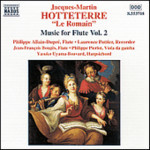
Music For Flute Vol. 2
 $25.00
Out of Stock
$25.00
Out of Stock6+ weeks add to cart
HOTTETERRE
Music For Flute Vol. 2
Philippe Allain-Dupre, Jean-Francois Bouges (flutes) with accompliment
[ NAXOS / CD ]
This item is currently out of stock. It may take 6 or more weeks to obtain from when you place your order as this is a specialist product.
Jacques Hotteterre, called le Romain, is one of the most illustrious figures in the history of the transverse flute.
At the same time a distinguished performer, an enlightened teacher and a recognised composer, he brought to the Baroque flute full respectability through his Livres de pièces (Books of Pieces), L'Art de Prélude (The Art of the Prelude) and his Principes de la Flûte (principles of the Flute). There are various confusions relating to Jacques Hotteterre, to whom the invention of the three-section Baroque flute is of !en wrongly attributed, whereas he was only its populariser.
Member of a great family of instrument-makers originating from Couture-Boussey in Normandy, Hotteterre was born in Paris on 29th September 1673. His father, Martin (1648-1712), was then a well known master instrument-maker, inventor of the little chalumeau on the musette and very probably the creator of the first German flutes in three sections, used from 1681 in Lully's orchestra.
Jacques Hotteterre and his brother Jean, known as the Elder (?-1720) had a good training and both learned the art of instrument-making. While the latter seems to have succeeded his father as a maker, the former preferred the ceremony of the court to the friendly atmosphere of the workshop. He followed his father as Grand Hautbois du Roi, a position that opened the way for him to the privileged royal musical establishment, the Chambre du Roi. From 1797 he began his musical career as a composer and teacher. It was in this year that he published his well known treatise Principes de la flûte traversière ou d'Allemagne, de la flûte à bec ou flûte douce et du hautbois (principles of the Transverse or German Flute, of the Recorder or Flauto Dolce and of the Oboe), which was re-issued many times up to 1765 and was translated into Flemish and even pirated in English.
Tracks:
L'Art de Preluder, Op. 7: Prelude in G minor
Suite No. 1 in G minor
Suite No. 2 (transposed into E minor for recorder)
De pieces a deux dessus: Suite No. 1
Suite No. 3 in D major
Suite Sonata No. 4 (transposed in D minor for recorder)



